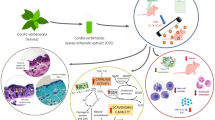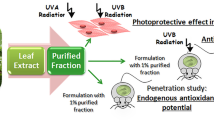Abstract
The skin is under continual assault from a variety of damaging environmental factors such as ultraviolet irradiation and atmospheric pollutants, and as organisms age the cumulative damage exceeds the capacity of endogenous antioxidant defenses resulting in chronic inflammation and premature aging. Botanical extracts such as Feverfew containing naturally occurring antioxidants could replenish the depleted cutaneous stores and perhaps forestall these degenerative changes. A parthenolide-depleted extract of Feverfew (PD-Feverfew), which was free of sensitization potential, was found to possess free radical scavenging activity against a wide range of reactive oxygen species and with greater activity than Vitamin C. In vitro, PD-Feverfew restored cigarette smoke-mediated depletion of cellular thiols, attenuated the formation of UV-induced hydrogen peroxide and reduced pro-inflammatory cytokine release. In vivo, topical PD-Feverfew reduced UV-induced epidermal hyperplasia, DNA damage and apoptosis. In a clinical study PD-Feverfew treatment significantly reduced erythema versus placebo 24 h post-UV exposure. Through the ability to scavenge free radicals, preserve endogenous antioxidant levels, reduce DNA damage and induce DNA repair enzymes, which can help repair damaged DNA, parthenolide-depleted extract of Feverfew may protect skin from the numerous external aggressions encountered daily by the skin and reduce the damage to oxidatively challenged skin.





Similar content being viewed by others
Explore related subjects
Discover the latest articles and news from researchers in related subjects, suggested using machine learning.Abbreviations
- ROS:
-
Reactive oxygen species
- UVA:
-
Ultraviolet A
- UVB:
-
Ultraviolet B
References
Afaq F, Mukhtar H (2002) Photochemoprevention by botanical antioxidants. Skin Pharmacol Appl Skin Physiol 15:297–306
Armeni T, Battino M, Stronati A, Pugnaloni A, Tomassini G, Rosi G et al (2001) Total antioxidant capacity and nuclear DNA damage in keratinocytes after exposure to H2O2. Biol Chem 382:1697–1705
Assefa Z, Van Laethem A, Garmyn M, Agostinis P (2005) Ultraviolet radiation-induced apoptosis in keratinocytes: on the role of cytosolic factors. Biochim Biophys Acta 1755:90–106
Aubin F (2003) Mechanisms involved in ultraviolet light-induced mmunosuppression. Eur J Dermatol 13:515–523
Babulak S, Rhein LD, Scala DD, Simion AF, Grove GL (1986) Quantitation of erythema in a soap chamber test using the Minolta chroma (reflectance) meter: comparison of instrumental results with visual assessments. J Soc Cosmet Chem 37:475–479
Bickers DR, Athar M (2006) Oxidative stress in the pathogenesis of skin disease. J Invest Dermatol 126:2565–2575
Bilimoria MH, Ecobichon DJ (1992) Protective antioxidant mechanisms in rat and guinea pig tissues challenged by acute exposure to cigarette smoke. Toxicology 72:131–144
Bombardelli E, Morazzoni P (2001) Tanacetum parthenium extract and method of obtaining same. United States Patent US6,224,875 B1
Carnevali S, Petruzzelli S, Longoni B, Vanacore R, Barale R, Cipollini M et al (2003) Cigarette smoke extract induces oxidative stress and apoptosis in human lung fibroblasts. Am J Physiol 284:L955–L963
D’Errico M, Lemma T, Calcagnile A, Proietti De Santis L, Dogliotti E (2007) Cell type and DNA damage-specific response of human skin cells to environmental agents. Mutat Res 614:37–47
El Hindi T, Ehlers G, Demchuk M, Pfitzner I (2004) Determination of the antioxidant capacity of an antioxidant combination using the fluoroscan assay in vitro and visualization of its effects using histological methods. Arch Dermatol Res 296:258–264
Gonzalez S, Astner S, An W, Goukassian D, Pathak MA (2003) Dietary lutein/zeaxanthin decreases ultraviolet B-induced epidermal hyperproliferation and acute inflammation in hairless mice. J Invest Dermatol 121:399–405
Groenewegen WA, Knight DW, Heptinstall S (1992) Progress in the medicinal chemistry of the herb feverfew. Prog Med Chem 29:217–238
Haratake A, Uchida Y, Schmuth M, Tanno O, Yasuda R, Epstein JH et al (1997) UVB-induced alterations in permeability barrier function: roles for epidermal hyperproliferation and thymocyte-mediated response. J Invest Dermatol 108:769–775
Hausen BM, Osmundsen PE (1983) Contact allergy to parthenolide in Tanacetum parthenium (L.) Schulz-Bip. (feverfew, Asteraceae) and cross-reactions to related sesquiterpene lactone containing Compositae species. Acta Derm Venereol 63:308–314
Heptinstall S (1988) Feverfew—an ancient remedy for modern times? J R Soc Med 81:373–374
Hoeijmakers JH (2001) Genome maintenance mechanisms for preventing cancer. Nature 411:366–374
Hu HL, Forsey RJ, Blades TJ, Barratt ME, Parmar P, Powell JR (2000) Antioxidants may contribute in the fight against ageing: an in vitro model. Mech Ageing Dev 121:217–230
Huang D, Ou B, Hampsch-Woodill M, Flanagan JA, Deemer EK (2002) Development and validation of oxygen radical absorbance capacity assay for lipophilic antioxidants using randomly methylated beta-cyclodextrin as the solubility enhancer. J Agric Food Chem 50:1815–1821
Jain NK, Kulkarni SK (1999) Antinociceptive and anti-inflammatory effects of Tanacetum parthenium L. extract in mice and rats. J Ethnopharmacol 68:251–259
Kligman LH (1989) The ultraviolet-irradiated hairless mouse: a model for photoaging. J Am Acad Dermatol 21:623–631
Kohen R, Gati I (2000) Skin low molecular weight antioxidants and their role in aging and in oxidative stress. Toxicology 148:149–157
Kurtz E, Walczak VR (2005) Clinical safety review of topical emollient formulations containing parthenolide-free-extract of Feverfew. J Am Acad Dermatol 52:P87
Kwok BH, Koh B, Ndubuisi MI, Elofsson M, Crews CM (2001) The anti-inflammatory natural product parthenolide from the medicinal herb Feverfew directly binds to and inhibits IkappaB kinase. Chem Biol 8:759–766
MacNee W, Bridgeman MM, Marsden M, Drost E, Lannan S, Selby C et al (1991) The effects of N-acetylcysteine and glutathione on smoke-induced changes in lung phagocytes and epithelial cells. Am J Med 91:60S–66S
Maia AM, Baby AR, Pinto CA, Yasaka WJ, Suenaga E, Kaneko TM et al (2006) Influence of sodium metabisulfite and glutathione on the stability of vitamin C in O/W emulsion and extemporaneous aqueous gel. Int J Pharm 322:130–135
Marks R (1995) An overview of skin cancers. Incidence and causation. Cancer 75:607–612
Muller T, Gebel S (1994) Heme oxygenase expression in Swiss 3T3 cells following exposure to aqueous cigarette smoke fractions. Carcinogenesis 15:67–72
Nakajima S, Lan L, Kanno S, Takao M, Yamamoto K, Eker AP et al (2004) UV light-induced DNA damage and tolerance for the survival of nucleotide excision repair-deficient human cells. J Biol Chem 279:46674–46677
Nguyen H, Finkelstein E, Reznick A, Cross C, van der Vliet A (2001) Cigarette smoke impairs neutrophil respiratory burst activation by aldehyde-induced thiol modifications. Toxicology 160:207–217
Nishi J, Ogura R, Sugiyama M, Hidaka T, Kohno M (1991) Involvement of active oxygen in lipid peroxide radical reaction of epidermal homogenate following ultraviolet light exposure. J Invest Dermatol 97:115–119
Ogura R, Sugiyama M, Nishi J, Haramaki N (1991) Mechanism of lipid radical formation following exposure of epidermal homogenate to ultraviolet light. J Invest Dermatol 97:1044–1047
Ou B, Hampsch-Woodill M, Prior RL (2001) Development and validation of an improved oxygen radical absorbance capacity assay using fluorescein as the fluorescent probe. J Agric Food Chem 49:4619–4626
Pathak MA, Stratton K (1968) Free radicals in human skin before and after exposure to light. Arch Biochem Biophys 123:468–476
Paulsen E, Christensen LP, Andersen KE (2007) Compositae dermatitis from airborne parthenolide. Br J Dermatol 156:510–515
Placzek M, Gaube S, Kerkmann U, Gilbertz KP, Herzinger T, Haen E et al (2005) Ultraviolet B-induced DNA damage in human epidermis is modified by the antioxidants ascorbic acid and D-alpha-tocopherol. J Invest Dermatol 124:304–307
Rahman I, MacNee W (1999) Lung glutathione and oxidative stress: implications in cigarette smoke-induced airway disease. Am J Physiol 277:L1067–L1088
Raitio A, Kontinen J, Rasi M, Bloigu R, Roning J, Oikarinen A (2004) Comparison of clinical and computerized image analyses in the assessment of skin ageing in smokers and non-smokers. Acta Dermatol Venereol 84:422–427
Reznick AZ, Cross CE, Hu ML, Suzuki YJ, Khwaja S, Safadi A et al (1992) Modification of plasma proteins by cigarette smoke as measured by protein carbonyl formation. Biochem J 286:607–611
Rittie L, Fisher GJ (2002) UV-light-induced signal cascades and skin aging. Ageing Res Rev 1:705–720
Rusznak C, Mills PR, Devalia JL, Sapsford RJ, Davies RJ, Lozewicz S (2000) Effect of cigarette smoke on the permeability and IL-1beta and sICAM-1 release from cultured human bronchial epithelial cells of never-smokers, smokers, and patients with chronic obstructive pulmonary disease. Am J Respir Cell Mol Biol 23:530–536
Schwarz T (1988) [The significance of epidermal cytokines in UV-induced immune suppression]. Der Hautarzt; Zeitschrift fur Dermatologie, Venerologie, und verwandte Gebiete 39:642–646
Sterenborg HJ, de Gruijl FR, van der Leun JC (1986) UV-induced epidermal hyperplasia in hairless mice. Photodermatol 3:206–214
Stewart MS, Cameron GS, Pence BC (1996) Antioxidant nutrients protect against UVB-induced oxidative damage to DNA of mouse keratinocytes in culture. J Invest Dermatol 106:1086–1089
Tanaka H, Ono Y, Nakata S, Shintani Y, Sakakibara N, Morita A (2007) Tobacco smoke extract induces premature skin aging in mouse. J Dermatol Sci 46:69–71
van der Vaart H, Postma DS, Timens W, ten Hacken NH (2004) Acute effects of cigarette smoke on inflammation and oxidative stress: a review. Thorax 59:713–721
Vayalil PK, Mittal A, Hara Y, Elmets CA, Katiyar SK (2004) Green tea polyphenols prevent ultraviolet light-induced oxidative damage and matrix metalloproteinases expression in mouse skin. J Invest Dermatol 122:1480–1487
Vink AA, Roza L (2001) Biological consequences of cyclobutane pyrimidine dimers. J Photochem Photobiol 65:101–104
Wang H, Kochevar IE (2005) Involvement of UVB-induced reactive oxygen species in TGF-beta biosynthesis and activation in keratinocytes. Free Radic Biol Med 38:890–897
Wang H, Liu X, Umino T, Skold CM, Zhu Y, Kohyama T et al (2001) Cigarette smoke inhibits human bronchial epithelial cell repair processes. Am J Respir Cell Mol Biol 25:772–779
Yoshida E, Watanabe T, Takata J, Yamazaki A, Karube Y, Kobayashi S (2006) J Invest Dermatol 126:1633–1640
Acknowledgments
We would like to acknowledge Devon Grote, Dara Miller and Judy Pinto for their technical contributions, and Claude Saliou for the helpful discussions on antioxidants. We would like to thank Dr. Lynne B. Harrison for guidance and discussion on the clinical erythema studies.
Open Access
This article is distributed under the terms of the Creative Commons Attribution Noncommercial License which permits any noncommercial use, distribution, and reproduction in any medium, provided the original author(s) and source are credited.
Author information
Authors and Affiliations
Corresponding author
Rights and permissions
About this article
Cite this article
Martin, K., Sur, R., Liebel, F. et al. Parthenolide-depleted Feverfew (Tanacetum parthenium) protects skin from UV irradiation and external aggression. Arch Dermatol Res 300, 69–80 (2008). https://doi.org/10.1007/s00403-007-0818-x
Received:
Revised:
Accepted:
Published:
Issue Date:
DOI: https://doi.org/10.1007/s00403-007-0818-x




